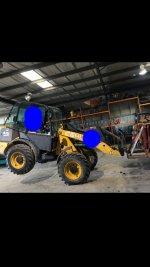MAYBE everyone is misunderstanding me... talking over the Internet is difficult..
Rear ballast weight does go onto the rear axles, but some of that added weight also transfers to the front when you have your FEL loaded.
I still aint sure if you get this or not. So I am gonna try one last time to spell it out. I think you get it. Because as long as your hydraulics are strong enough to lift the @$$ of the tractor, then yes, the more weight ultimately adds to the front end.
Tractor comes with just a bare machine and no ballast.
No ballast. 4000# tractor + loader. Loader can only lift 400# before the rear end comes off the ground.
4400# is now on front axle
Add 400# rear ballast. This allows you to lift 700# with the front end loader before rear end hikes.
5100# is now on front
Add 600# ballast. This allows you to lift the full max 1000# of the loader, but the rears are just floating. for all intents everything is on the front. We now have
5600# on the front.
5600# is the MOST the front is gonna see. ANY additional weight above and beyond the 600# is now gonna start reducing the front axle load and adding it back to the rear.
800# on the rear (200# more than just floating the rear end). Lets say that additional 200# of ballast transfers 150# back off the front end. We now have a total tractor weight of 5800#, but only 5450# now on the front.
Lets jump to a 1200# weight This might transfer another 300-400 off the front. So now we have a tractor with a total weight of 6200# and only 5000# over the front when in MAX lift mode. and keeping 1200# on the rears as opposed to very little.
These numbers arent representative of anything, just for illustration purposes.
But I think the issues lies with you thinking that just because I add more weight to the back automatically means I am gonna lift more weight up front as a result. And yes.....if thats what I do, then yes, thats more weight on the front.
I am talking about like for like. Let me end with a simple question to see If you have a good grasp.
If I have a 2000# pallet I want to move with my pallet forks....and I put my 1200# rear blade on I can move it. I can ALSO put my 1600# mower on (same weight center behind rear axle) and move said pallet.
Which one is gonna have the least load on the front axle? ---^--0---
---^--0--- ---^--0---
---^--0---
